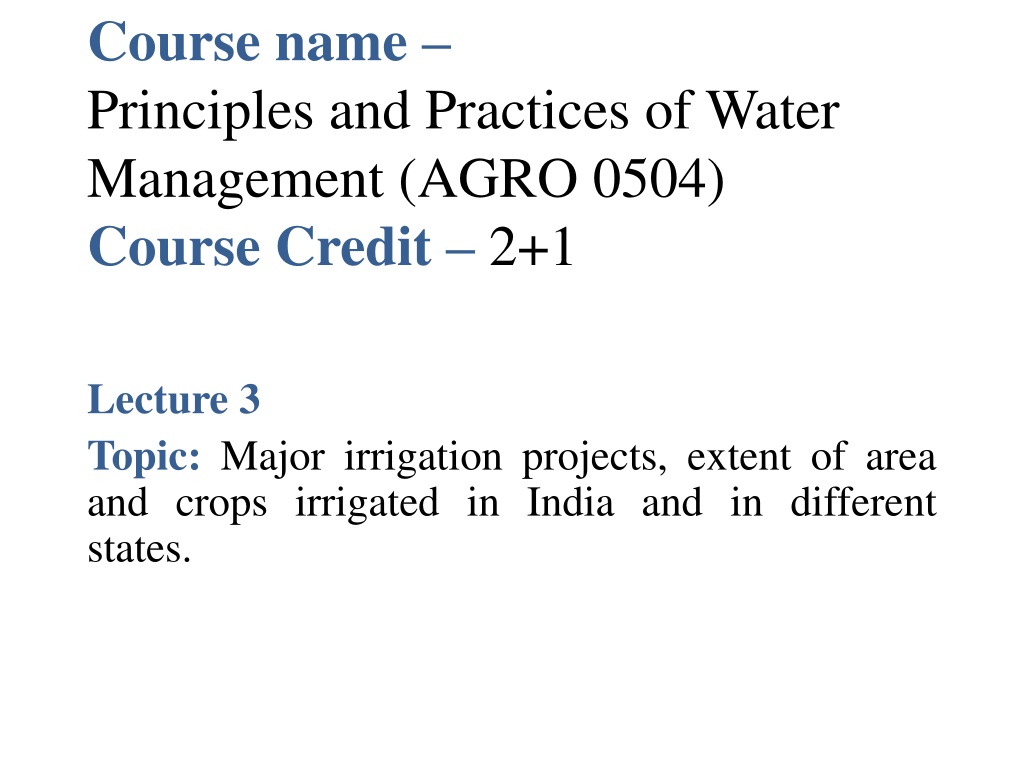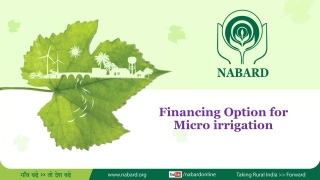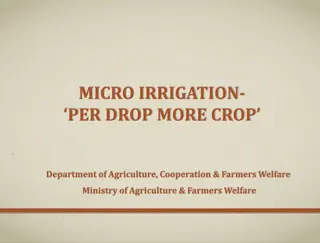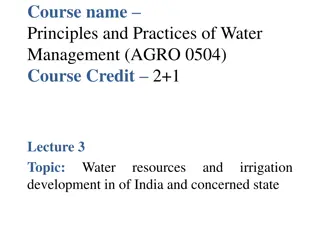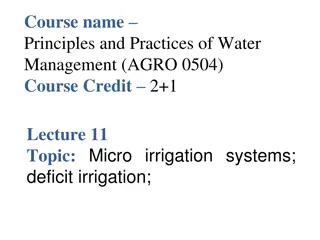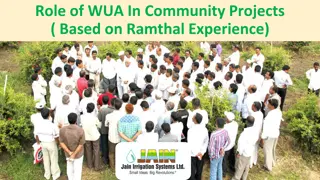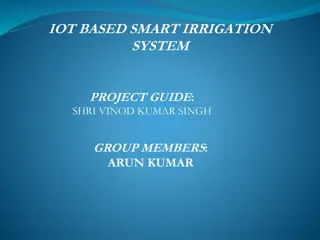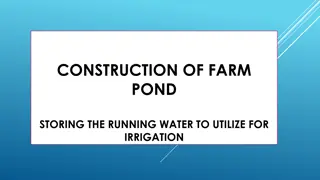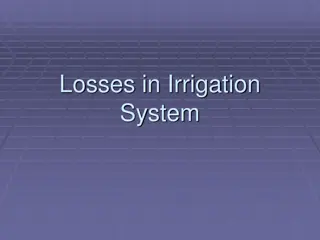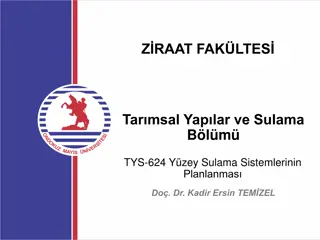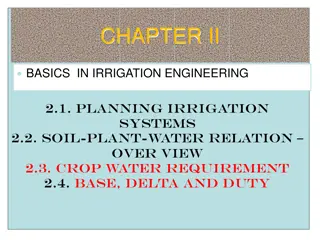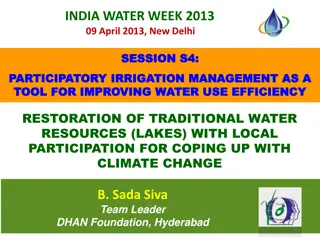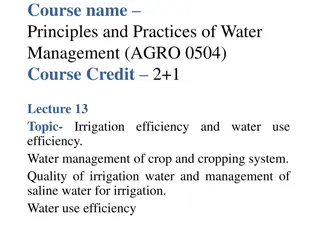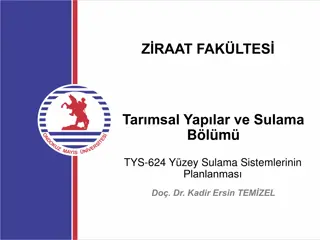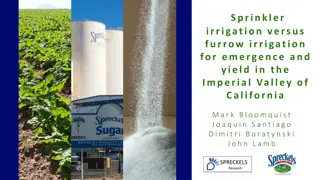Primer on Major, Medium, and Minor Irrigation Projects in India
Explore the classification and methods of major, medium, and minor irrigation projects in India, including direct and indirect irrigation methods, gravity flow schemes, and lift irrigation systems.
Download Presentation

Please find below an Image/Link to download the presentation.
The content on the website is provided AS IS for your information and personal use only. It may not be sold, licensed, or shared on other websites without obtaining consent from the author. Download presentation by click this link. If you encounter any issues during the download, it is possible that the publisher has removed the file from their server.
E N D
Presentation Transcript
Course name Principles and Practices of Water Management (AGRO 0504) Course Credit 2+1 Lecture 3 Topic: Major irrigation projects, extent of area and crops irrigated in India and in different states.
Major , minor and medium irrigation projects
Major Irrigation Projects: The area envisaged to be covered under irrigation is of the order over 10000 hectare (CCA>10,000 ha). This type of project consist huge storage reservoirs, flow diversion structures and a large network of canals. These are often multi-purpose projects serving other aspects like flood control and hydro power. Medium Irrigation Projects: Projects having CCA less than 10,000 ha but more than 2,000 ha are classified as medium irrigation projects. These are also multi-purpose surface water projects. Medium size storage, diversion and distribution structures are the main components of this type of project. Minor Irrigation Projects: Projects having CCA less than or equal to 2,000 ha are termed as minor irrigation project. The main sources of water are tanks, small reservoirs and groundwater pumping. A number of minor irrigation projects may exist individually within the command area of a major or medium irrigation project.
The Major and Medium Irrigation (MMI) projects are further classified into two types based on irrigation method adopted. Direct Irrigation method: In this method water is directly diverted from the river into the canal by the construction of a diversion structure like weir or barrage across the stream without attempting to store water. This method is practiced where the stream has adequate perennial supply. Direct irrigation is usually practiced in deltaic tracts that is, in areas having even and plane topography. Indirect or Storage Irrigation Method: In this system, water is stored in a reservoir during monsoon by construction of a dam across the river. The stored water is diverted to the fields through a network of canals during the dry period. Evidently indirect irrigation is adopted where the river is not perennial or flow in the river is inadequate during lean period.
Based on the Way of Water Application The Irrigation schemes are classified into two types based on way of water application. Gravity/Flow Irrigation Scheme: This is the type of irrigation system in which water is stored at a higher elevation so as to enable supply to the land by gravity flow. Such irrigation schemes consists head works across river to store the water and canal network to distribute the water. The gravity irrigation scheme is further classified as: Perennial Irrigation Scheme: In this scheme assured supply of water is made available to the command area throughout the crop period to meet irrigation requirement of the crops. Non-Perennial Irrigation (Restricted Irrigation) Scheme: Canal supply is generally made available in non-monsoon period from the storage. Lift Irrigation Scheme: Irrigation systems in which water has to be pumped to the field or canal network form lower elevations are categorised as lift irrigation schemes.
SOME IRRIGATION AND MULTIPURPOSE PROJECTS Bargi Project (Madhya Pradesh): It is a multipurpose project consisting of a masonry dam across Bargi river in the Jabalpur district and a left bank canal. Beas Project (Joint venture of Haryana, Punjab and Rajasthan): It consists of Beas-Sutlej Link and Beas Dam at Pong. Bhadra Project (Karnataka): A multipurpose project across the river Bhadra. Bhakra Nangal Project (Joint project of Haryana, Punjab, and Rajasthan): India's biggest, multipurpose river valley project comprises a straight gravity dam across the Sutlej river at Bhakra, the Nangal dam, the Nangal hydel channel, two power houses at Bhakra dam and two power stations at Ganguwal and Kotla. Bhima Project (Maharashtra): Comprises two dams, one on the Pawana river near Phagne in Pune district and the other across the Krishna river near Ujjaini in Sholapur district. Chambal Project (Joint project of Madhya Pradesh and Rajasthan): The project comprises Gandhi Sagar dam, Rana Pratap Sagar dam and jawahar Sagar dam.
Damodar Valley Project (West Bengal and Bihar): A multipurpose project for the unified development of irrigation, flood control and power generation in West Bengal and Bihar. It comprises multipurpose dams at Konar, Tilaiya, Maithon and Pancher; hydel power stations at Tilaiya, Konar, Maithon and Panchet; barrage at Durgapur; and thermal power houses at Bokaro, Chandrapura and Durgapur. The project is administrated by the Damodar Valley Corporation. Dulhasti Power Project (Jammu & Kashmir): It is a 390 MW power project in Kishtwar region of Jammu & Kashmir on Chenab river. Work for this project started in 1981. The foundation stone was laid on April 15, 1983 by the then Prime Minister, Indira Gandhi. Work on this project was suspended due to threats of kidnapping and killings by Kashmiri militants resulting in long delay in completion of project. Farakka Project (West Bengal): The project was taken up for the preservation and maintenance of Calcutta port and for improving the navigability of the Hoogly. It comprises a barrage at Jangipur across the Bhagirathi and a feeder channel taking off from the Ganga at Farakka and tailing into the Bhagirathi below the Jangipur barrage. Gandak Project (Joint project of Bihar and Uttar Pradesh): Nepal also derives irrigation and power benefits form this project.
Ghataprabha Project (Karnataka): A project across Ghataprabha in Belgaum and Bijapur districts. Hirakund (Odisha): World's longest dam, is located on the Mahanadi river. Jayakwadi Project (Maharashtra): A masonry spillway across the river Godavari. Kahalgaon Project (Bihar): The 840-MW Kahalgaon Super Thermal Power Project, a joint venture between National Thermal Power Corporation and the Russian State Enterprise Foreign Economic Association, was on August 12,1996 commissioned and put into commercial operation. Kakrapara Project (Gujarat): On the Tapti river near Kakrapara, in Surat district. Kangsabati Project (West Bengal): The project, put in operation in 1965, is located on the Kangsabati and Kumari rivers. Karjan Project (Gujarat): A masonry dam across Karjan river near Jitgarh village in Nandoo Taluka of Bharuch district. Kosi Project (Bihar): A multipurpose project, which serves Bihar and Nepal. Koyna Project (Maharashtra): It is built on a tributary of river Krishna with a capacity of 880 MW. It feeds power to Mumbai-Pune industrial belt. Krishna Project (Maharashtra): Dhom dam near Dhom village on Krishna and Kanhar dam near Kanhar village on Varna river in Satna district.
Kukadi Project (Maharashtra): Five independent storage dams, i.e. Yodgaon, Manikdohi, Dimbha, Wadaj and Pimpalgaon Jog. The canal system comprises (i) Kukadi left bank Canal, (ii) Dimbha left bank canal, (iii) Dimbha right bank canal, (iv) Meena feeder and (v) Meena branch. Kundoh Project (Tamil Nadu): It is in Tamil Nadu whose initial capacity of 425 MW has since been expanded to 535 MW. Let Bank Ghaghra Canal (Uttar Pradesh): A link channel taking off from the left bank of Ghaghra river of Girja barrage across Sarju.
Madhya Ganaga Canal (Uttar Pradesh): A barrage across Ganga in Bijnore district. Mahanadi Delta Scheme (Odisha): The irrigation scheme will utilize releases from the Hirakud reservoir. Mahanadi Reservoir Project (Madhya Pradesh): It has three phases: (1) Ravishankar Sagar Project and feeder canal system for supply of water of Bhilai Steel Plant and Sandur dam across Sandur village. (2) Extension of Mahanadi feeder canal. (3) Pairi dam. Mahi Project (Gujarat): A two phase project, one across the Mahi river near Wanakbori village and the other across Mahi river near Kadana. Malaprabha Project (Karnataka): A dam across the Malaprabha in Belgaum district. Mayurakshi Project (West Bengal): An irrigation and hydro-electric project comprise the Canada dam.
Minimato Bango Hasdeo Project (Madhya Pradesh): This project is locted at Hasdeo Bango river in Korba district and envisages construction of a masonry dam. A hydel power plant of 120 MW capacity has been commissioned on the Bango dam. Nagarjunasagar (Andhra Pradesh): On the Krishna river near Nandikona village (about 44 km from Hyderabad). Panam Project (Gujarat): A gravity masonry dam across Panam river near Keldezar village in Panchmahal district. Parambikulam Aliyar (Joint venture of Tamil Nadu and Kerala): The integrated harnessing of eight rivers, six in the Annamalai Hills and two in the plains. Pochampad (Andhra Pradesh): Across Godavari river. Pong Dam (Punjab): It is an important hydro-electric project located on Beas river.
Rajasthan Canal (Indira Gandhi Canal- Rajasthan): The Project uses water released from Pong dam and provides irrigation facilities to the north-western region of Rajasthan, i.e., a part of the Thar desert. It consists of Rajasthan feeder canal (with the first 167 km in Punjab and Haryana and the remaining 37 km in Rajasthan) and 445 km Rajasthan main canal entirely in Rajasthan. Rajghat Dam Project (Madhya Pradesh): The Rajghat Dam and Rajghat Hydro Electric Projects are Inter-State projects of MP and UP. The Rajghat Dam is almost complete. All the three units of Rajghat Hydro-Electric Project had been synchronized during 1999 and power generation has been continuing ever since. Ramganga (Uttarakhand): A dam across Ramganga, a tributary of the Ganga river located in Garhwal district. The project has, besides reducing the intensity of floods in central and western Uttar Pradesh, provided water for the Delhi water supply scheme. Ranjit Sagar Dam (Thein Dam) (Punjab): A multi-purpose highest dam in the country, built on the Ravi river for the benefit of Punjab, Haryana and Jammu and Kashmir. Rihand Project (Uttar Pradesh and Madhya Pradesh): It is the largest man-made lake in India on the borders of Uttar Pradesh and Madhya Pradesh with a capacity of 300 MW annually.
Sabarmati (Gujarat): A storage dam across Sabarmati river near Dhari Village in Mehsana district and wasna barrage near Ahmedabad. Salal Project (Jammu & Kashmir): With the successful completion of the 2.5-km long tailrace tunnel, the 690-MW Salal (Stage I and II ) project in Jammu and Kashmir became fully operational on August 6, 1996. Sarda Sahayak (Uttar Pradesh): A barrage across the river Ghaghra, a link channel, a barrage across River Sarda and a feeder channel of two major aqueducts over rivers Gomti and Sai. Sharavathi Project (Karnataka): It is located at the Jog Falls with a capacity of 891 MW. It primarily feeds Bengaluru industrial region and also Goa and Tamil Nadu. Sone High Level Canal(Bihar): An extension on Sone Barrage project. Tawa Project (Madhya Pradesh): A project across the Tawa river, a tributary of the Narmada in Hoshangabad district.
Tehri Dam Project (Uttarakhand): Earth and rock-fill dam on Bhagirathi river in Tehri district. Tungabhadra Project (Joint Project of Andhra Pradesh and Karnataka): On the Tungabhadra River. Ukai Project (Gujarat): A multipurpose project across Tapti river near Ukai village. Upper Krishna Project (Karnataka): A project consisting of Narayanpur dam across the Krishna river and a dam at Almatti. Upper Penganga Project (Maharashtra): Two reservoirs on Penganga river at Isapur in Yavatmal district and the other on Rayadhu river at Sapli in Parbhani district. Uri Power Project (Jammu & Kashmir): It is located on the river Jhelum in the Uri Tehsil of Baramulla district in Jammu & Kashmir. It is a 480-MW hydroelectric project which was dedicated to the nation of February 13, 1997.
Water Scenario in India : Some Facts 2 % of world s geographical area 4 % of freshwater resources 17 % of world s population 15 % of livestock 63% of cultivated area is Rainfed 18% of area is arid area
National Water Resources of India Quantity (M ha m) Precipitation (%) Sl. No. Resource 1 Annual precipitation (including snowfall) Evaporation + groundwater Average annual potential flow in rivers 400 100 2 3 213.1 186.9 53.3 46.7 Estimated utilizable water resources 4 112.2 28.1 4(i). 69 17.3 Estimated utilizable surface water Replenishable groundwater 4(ii). 43.2 10.8
GROUND WATER RESOURCE OF INDIA Quantity (M ha m) Sl. No. Resource 1 2 3 4 Total replenishable groundwater Provision for domestic, industrial and other uses Available groundwater resource for irrigation Utilizable groundwater resource for irrigation (90% of sl.no.3) Total utilizable groundwater resource (sum of sl.no.2 and 4) 43.2 7.1 36.1 32.5 5 39.6
REGION-WISE WATER RESOURCE SCENARIO OF INDIA Average Rainfall (mm) Net Ground Water Resources M Ha m Ground Water Development Ultimate irrigation potential, M ha Surface Ground Irrigated area, M ha Region Total Eastern 1526 19.61 13.92 33.53 14.44 19.45 33.00 Southern 1593 15.2 10.24 25.44 8.57 7.28 35.18 Western 1195 20.29 17.95 38.23 15.36 8.32 38.01 Northern 988 20.74 21.95 42.69 15.98 10.24 43.74 All India 1325 75.84 64.05 139.9 54.35 45.34 37.48
Projected water requirement for different uses in world (M ha m) Uses 1995 2010 2025 Irrigation 143.6 143.6 149.3 Domestic 16.9 23.4 29.0 Industries 15.7 21.1 23.6 Livestock 3.7 4.9 6.3 Total 179.9 193.0 208.2
Issues and Challenges in Water Sector Declining per Capita Water Availability Rising multi-sect oral Demand Reducing Trend of Budget Outlay for Irrigation Sector Equity in Supply of Water for irrigation Difficult sites for Projects Environment and Water Quality Over-exploitation of Ground Water
Water Availability in India I. II. III. Total annual rainfall: 400 m ha m (a) Evaporation to atmosphere: 130 m ha m (b) Surface flow to rivers etc.: 185 m ha m (c) Soil profile storage & Groundwater: 85 m ha m IV. Utilizable Water: 140 m ha m (a) Surface flow (rivers, ponds etc.): 76 m ha m (b) Groundwater: 64 m ha m Average annual rainfall: 1120 mm Total Geographical area: 328 m ha Source: National Commission on Agriculture (1976), Central Water commission (1996)
Annual Per Capita Water Resource in Selected Countries (2000-01) Water Availability '000 cu meter Bhutan Lao PDR Cambodia Myanmar Malaysia Bangladesh Indonesia Nepal Water Availability '000 cu meter Vietnam Phillipines Thailand Afganistan Sri Lanka India PRC Pakistan 0 10 20 30 40 50 60 70
Water Availability Year 2001 Per Capita Availability 1869 m3 (comfortable) 2025 1341 m3 (stress level) 2050 1140 m3 (scarcity level) (Source: Ministry of Water Resources)
On the basis of the recommendations of the Committee of Ministers, Government of India launched a Centrally Sponsored Scheme of Command Area Development Programme in 1974-75. The programme envisaged an integrated and coordinated approach to the development and management of command areas by constituting a multi-disciplinary team under the overall control of the Command Area Development Authorities. The programme was restructured and renamed as "Command Area Development and Water Management (CADWM) Programme" from 1st April 2004. The CAD programme was initiated with 60 major and medium irrigation projects. So far 332 irrigation projects with a Culturable Command Area (CCA) of about 29 million ha spread over 23 States and 2 Union Territories have been included under the programme, out of which 138 projects are currently under implementation. CADWM Objective To bridge the gap between the irrigation potential created and that utilized through increase in irrigated areas and thereon to increase efficient utilization of irrigation water and improve the agricultural productivity in the irrigation commands .
Reasons for lag in irrigation potential created to that of utilization a) Deficiencies in design and operational procedures b) Unlined conveyance systems and uncontrolled and improper water distribution systems c) Lack of on-farm development works and land consolidation for better water management d) Irrigation methods followed are biblical in nature i.e., field to field irrigation with uncontrolled wild flooding system e) Irrigation scheduling in most projects is still based on conventional approaches f) Complete negligence of drainage component in command areas g) Inappropriate irrigation water pricing policy i.e., pricing based on irrigated acreage rather than irrigation quantity h) Changes in cropping pattern assumed at the time of designing the project and that followed by farmers i) Cultivation of rice in areas localized for ID crops j) Absence of feed-back from farmers k) Lack of coordination between different agencies i.e., extension workers, irrigation engineers, research scientists and farmers l) Inadequate infrastructure of extension services
Functions of CADWM 1. On-farm development through systematic land leveling and land shaping of areas under the projects 2. Planning & construction of field channels, drains and farm roads 3. Modernisation, maintenance & efficient operation of irrigation systems Page 25 4. Development, maintenance & operation of drainage systems 5. Selection, introduction and enforcement of suitable cropping patterns 6. Introduction & enforcement of a proper rotational irrigation practice i.e., warabandhi system and equitable distribution of water to the individual fields 7. Conjunctive use of surface and ground water resources 8. Introduction of suitable cropping patterns 9. Propagation, demonstration and implementation of improved water management techniques, education and training of farmers in irrigated agriculture 10. Localization and relocalisation of lands on sound principles 11. Strengthening of existing agricultural extension activities 12. Planning for timely and adequate supply of various crop production inputs viz., seeds, fertilizers, pesticides, herbicides vis- -vis credit facilities 13. Creation and development of marketing, processing and warehouse facilities
Water is Life Conserve it Use it Judiciously We know the Malady There is a Remedy Need is will for Implementation Live and Let Live
